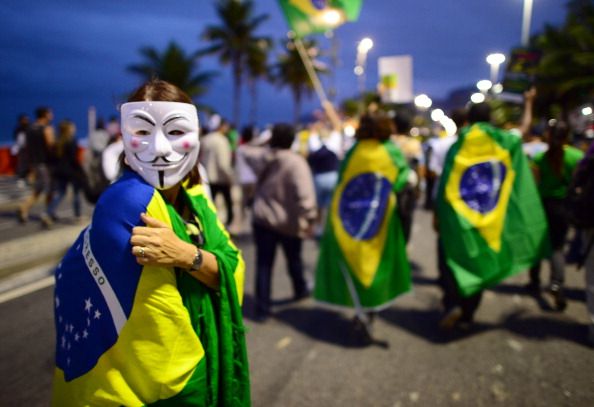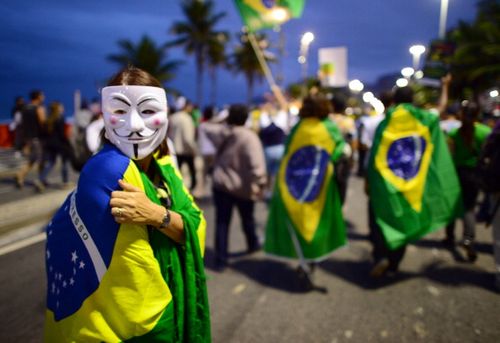
"Chaos"federations Cup: Samba on the streets of Brazil

The Guy Fawkes masks and street graffiti proclaiming “revolution” and “Hate Police” could be easily be mistaken for the Occupy Wall Street protests or even the recent Taksim Square protests. But this is all happening in Brazil: not in its sun kissed sand beaches or in the picturesque landscape beneath the open arms of Christ the Redeemer; it’s happening in the streets of Brazil.
An 8% hike in public transport fares snowballed into massive chaos and anger against the Brazil government. Hundreds of thousands of Brazilians from eight states are now demanding for a zero-fare-transport. The plans for an 8% hike, which amounts to just 0.20 Brazilian Real (about Rs.5), were rolled back, but there is still visible anger against President Dilma Rouseff.
The protests that began in Sao Paolo on July 11, and later spread to other cities, resulted in four deaths and damage to the public property. The people are demanding for better education and health services. Their anger is further fuelled by high taxes and expensive World Cup match tickets.
These protests come when Brazil is organizing a dress rehearsal for the 2014 WC – the Confederations Cup. The tournament was nearly cancelled due to the violence on the streets across Brazil. Several Brazil players like Neymar, Hulk and Dani Alves voiced their support to the protests.
In a damning comment piece by Brazil football legend Romario in a reputed British daily, he attacked the government for the escalating costs in building the stadium for World Cup 2014. And, most importantly, channelling public money towards “sport projects, at the expense of health, education and safety.”
Romario says: “An initial budget of R$25.5bn ($11.4bn) for stadiums, urban transportation, improvements in ports and airports, has risen to R$28bn, according to the sports ministry’s executive secretary, Luiz Fernandes – almost three times the cost of Germany’s World Cup in 2006. Why are we organising the most expensive World Cup in history, without any of the benefits to the community we were promised?”
A famous former editor once said “comment is free, but facts are sacred”. Romario made his comments without thinking about the rise in inflation, and he was comparing Germany’s infrastructure to Brazil’s. If the cost to construct the 70,000-seat Mane Garrincha stadium is taken as an average for all the 12 venues, then it would still cost just around £4bn. Where is the rest of money (£5bn) going? It is going towards improving the infrastructure like roads, transport connectivity and airports. When Germany hosted the World Cup they definitely did not need to spend more money on infrastructure than what they had spent on building and improving football stadiums. There is a reason they are part of the G8 and Brazil is not.
Ramario also accuses that corruption is rife in the current government. This may be dismissed as mere accusations from an opposition party member (Romario is a Congressman), but if you have seen Jose Padilha’s “Tropa de Elite” films, you’ll know to think otherwise. Despite Brazil being the sixth largest economy in the world they are facing an economic slowdown. Forbes magazine lays the blame on President Rouseff’s government for Brazil’s economic downward spiral. The government granted low interest loans through state-controlled banks to their friends in the private sector and now they face the possibility of loan default.
And then there is the debate about what will happen to the stadiums after the World Cup. What everybody seems to be forgetting is the fact that Brazil also won the bid to host the 2016 Olympics. According to the accounting firm Ernst & Young, “the World Cup and the Olympics together will generate 3.6m jobs and contribute 0.4 per cent of GDP a year until 2019.”

The only sticking point about next year’s World Cup is that it will price out the middle class fans, and will be far from affordable for those living in poverty. The same goes for the travelling fans, who may be already dreaming of getting a sun tan whilst sipping pina colada’s out of a coconut.